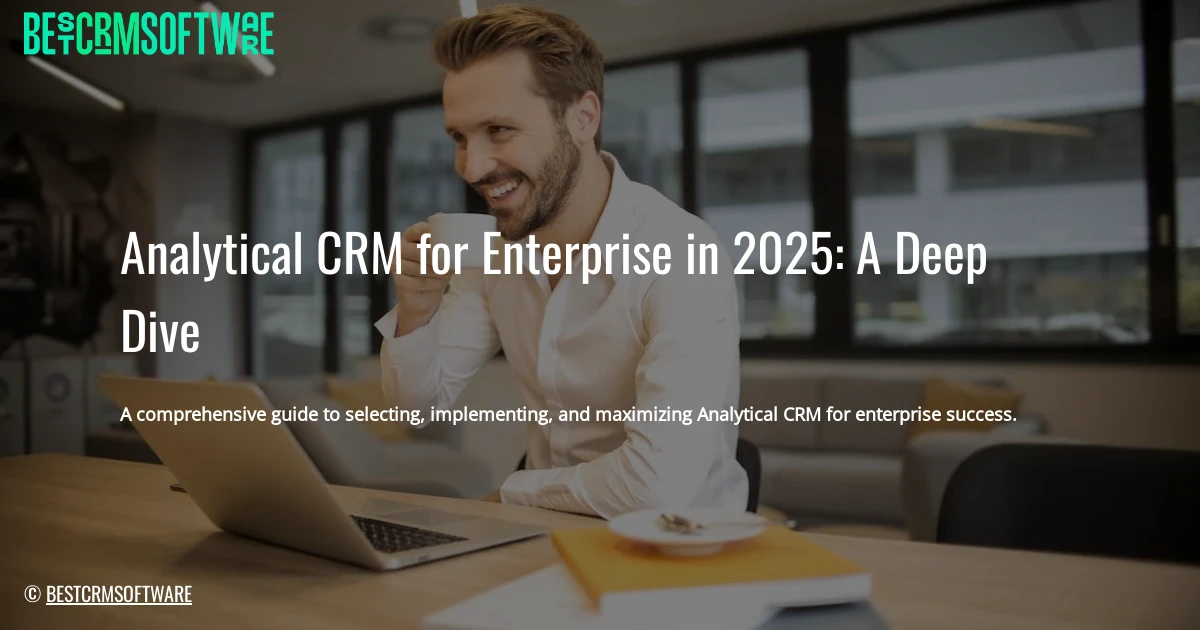A comprehensive guide to selecting, implementing, and maximizing Analytical CRM for enterprise success.
Introduction: The Age of Data-Driven Enterprise
The world of customer relationship management (CRM) is undergoing a significant transformation, evolving from traditional, transactional systems to a more sophisticated, analytical approach. This shift is driven by the increasing volume and accessibility of data, coupled with the ever-growing need for enterprises to make data-driven decisions.
Defining Analytical CRM and its evolution by 2025:
Analytical CRM takes a proactive and predictive approach to managing customer relationships. Unlike traditional CRM, which primarily focuses on tracking interactions and storing customer information, Analytical CRM utilizes advanced analytics and artificial intelligence (AI) to glean actionable insights from customer data. These insights help enterprises understand customer behavior, predict their needs, and tailor their marketing and sales strategies accordingly.
By 2025, Analytical CRM is expected to become even more pervasive and sophisticated. Integration with real-time data streams, the rise of machine learning algorithms, and the adoption of AI-powered tools will drive a deeper level of customer understanding. This will lead to:
- Personalized experiences: Businesses will leverage data to deliver highly tailored messages, offers, and content that resonate with each customer’s unique needs and preferences.
- Predictive analytics: Advanced algorithms will forecast customer churn, identify potential leads, and optimize marketing campaigns for higher conversion rates.
- Automated customer journeys: From initial contact to post-sale interactions, entire customer journeys can be streamlined and personalized based on insights generated from their data.
Importance of data-driven decision making for enterprises:
In today’s hyper-competitive business environment, enterprises that rely on intuition and anecdotal evidence often struggle to compete. Data-driven decision making, fueled by analytical CRM, offers a clear advantage:
- Increased efficiency: Insights derived from customer data can be used to optimize sales processes, automate marketing campaigns, and streamline customer service, improving operational efficiency.
- Enhanced customer satisfaction: Understanding customer needs and preferences allows businesses to provide personalized solutions and exceptional customer experiences, fostering loyalty and retention.
- Improved profitability: Analytical CRM helps identify lucrative customer segments, optimize marketing spend, and personalize sales efforts, resulting in higher conversion rates and increased revenue.
Benefits of Analytical CRM over traditional CRM approaches:
While traditional CRM offers a valuable foundation for managing customer interactions, Analytical CRM provides a distinct edge:
- Predictive insights: By leveraging advanced analytics, businesses can predict customer behavior, anticipate future needs, and proactively address potential problems, rather than reacting to issues after they arise.
- Actionable intelligence: Analytical CRM transforms raw data into actionable insights, providing a roadmap for optimizing business operations, enhancing customer relationships, and achieving business objectives.
- Data-driven automation: Analytical CRM facilitates automation of tasks that were traditionally manual, freeing up employees to focus on high-value activities and creating more efficient workflows.
As we enter the age of data-driven enterprises, Analytical CRM is poised to revolutionize the way businesses interact with their customers. The organizations that effectively leverage this technology will gain a significant competitive advantage in the years to come.
The Evolving Landscape of CRM in 2025
The CRM market is in a constant state of evolution, driven by rapid technological advancements and changing customer expectations. As we approach 2025, this evolution is accelerating, creating both challenges and opportunities for businesses.
Current state of the CRM market and future projections:
The global CRM market is expected to reach \$80 billion by 2025, driven by the increasing adoption of cloud-based solutions, mobile applications, and AI-powered features. Businesses are realizing the strategic value of CRM in optimizing customer engagement, improving sales efficiency, and increasing customer loyalty.
While traditional CRM systems focused on basic functionalities like data management and lead generation, the future is characterized by:
- Shift from transactional to personalized experiences: Customers demand tailored interactions, which requires deep insights derived from data analytics.
- Increased focus on automation: Businesses will seek to automate tasks like lead qualification, nurturing, and personalized outreach through AI and ML.
- The rise of customer data platforms (CDPs): CDPs will become integral to CRM systems, unifying customer data across multiple sources for a comprehensive view.
Emerging trends shaping the CRM landscape (AI, ML, Big Data):
The emergence of advanced technologies is fundamentally reshaping the CRM landscape:
- Artificial intelligence (AI): AI is powering intelligent CRM functionalities, enabling automated customer service interactions, personalized recommendations, and predictive insights.
- Machine learning (ML): ML algorithms are crucial for pattern recognition, sentiment analysis, and customer segmentation.
- Big data analytics: Businesses are leveraging vast datasets to understand customer behavior, preferences, and churn risk, driving informed marketing strategies.
These technologies are creating an intelligent CRM ecosystem that automates processes, enhances customer experiences, and optimizes resource allocation.
Competitive advantages of early adoption of advanced Analytical CRM:
Early adopters of advanced Analytical CRM solutions enjoy a significant competitive edge by:
- Improved customer engagement: By harnessing AI and ML, businesses can anticipate customer needs and tailor communication for optimal engagement, leading to higher customer satisfaction and loyalty.
- Enhanced marketing ROI: Advanced analytics enable data-driven campaign targeting, optimization, and performance measurement, ensuring better return on marketing investments.
- Proactive sales & customer support: Predictive analytics allow for anticipating potential sales opportunities and customer issues, enabling businesses to be proactive and responsive, leading to increased conversion rates and customer retention.
- Data-driven decision-making: Advanced CRM platforms provide actionable insights across the customer journey, facilitating informed decision-making that aligns with evolving market trends.
In essence, embracing analytical CRM today provides a strategic advantage in navigating the competitive landscape of 2025 and beyond. The ability to leverage data-driven insights for personalized experiences, operational efficiency, and customer loyalty will be crucial for business success in the future.

© Christina Morillo
Assessing Your Enterprise Needs
Before diving into the technical intricacies of Analytical CRM in 2025, it’s crucial to understand your unique enterprise context. This involves taking stock of your existing needs, challenges, and desired outcomes. Here are three key areas to focus on:
1. Understanding the Specific Needs and Challenges of Your Enterprise:
- What are the primary goals for your CRM system? Is it primarily focused on customer acquisition, retention, upselling, cross-selling, or a combination of these?
- What pain points are you facing with your current CRM system (if any)? Are you struggling with data quality, integration issues, lack of insights, or limited functionality?
- What are your current business processes and how do they relate to your CRM? Are processes clearly defined and documented?
- What are the specific needs and challenges of different departments within your organization? How do marketing, sales, customer support, and other teams interact with customers?
- What are the data privacy and security requirements for your organization? Are there any regulations or industry-specific guidelines that need to be considered?
2. Identifying Key Performance Indicators (KPIs) for CRM Success:
- Define measurable targets for each stage of the customer journey. This could include lead generation rates, conversion rates, customer lifetime value, customer satisfaction scores, churn rates, and more.
- Ensure your KPIs align with your overarching business goals. What metrics will truly drive value and help you achieve success in the long run?
- Establish clear benchmarks and tracking methods. How will you measure and monitor progress towards your defined KPIs?
3. Setting Realistic and Measurable Goals for Analytical CRM Implementation:
- Avoid setting unrealistic expectations. Don’t expect an immediate overhaul or overnight success.
- Prioritize and focus on achievable goals. Identify areas where Analytical CRM can deliver the most impact within a defined timeframe.
- Set measurable objectives with clear deadlines. This allows for progress monitoring and adjustments along the way.
- Consider both short-term and long-term goals. How will you evolve your CRM strategy over time to meet evolving business needs?
By taking the time to comprehensively assess your enterprise needs, you will be better equipped to make informed decisions about your Analytical CRM strategy and implementation. This groundwork will ensure a successful transition and pave the way for maximized benefits in the years to come.
Building a Solid Data Foundation
Analytical CRM’s power lies in its ability to extract valuable insights from data. This section will explore the crucial elements of establishing a robust data foundation for your Analytical CRM system, encompassing the sources, integration techniques, and measures to ensure data quality, security, and compliance.
Data Sources for Analytical CRM:
- Internal Systems: The backbone of your data foundation will be the internal systems that hold customer interactions. These include:
- CRM system: Sales, marketing, and customer support activities provide a wealth of customer data, from contact details to interaction history, opportunities, and feedback.
- ERP system: Finance and supply chain data reveal customer spending patterns, order history, and product preferences.
- Website Analytics: Web traffic data, browsing patterns, and engagement metrics offer valuable insights into customer behaviour.
- Email marketing platforms: Open and click rates, unsubscribe rates, and email interactions shed light on communication effectiveness.
- Social media monitoring tools: Sentiment analysis, brand mentions, and customer conversations provide crucial information about public perception.
- External Data: While internal data is critical, external data sources can significantly enhance your analytical insights. These include:
- Third-party data providers: Enrich customer profiles with demographics, psychographics, location data, and financial information.
- Industry benchmarks: Gain competitive advantage by understanding industry trends and performance metrics.
- Public data: Utilise free, publicly available datasets from government agencies, research institutions, and news platforms for demographic trends, economic indicators, and competitive intelligence.
Data Integration Techniques and Best Practices:
- Extract, Transform, Load (ETL): This traditional method involves extracting data from various sources, transforming it into a uniform format, and loading it into a data warehouse for analysis.
- Data Pipelines: Modern pipelines offer automated data extraction, transformation, and loading processes, improving efficiency and agility. Tools like Apache Kafka and AWS Kinesis facilitate near real-time data integration.
- Cloud-based solutions: Cloud data warehousing platforms like Snowflake, Amazon Redshift, and Google BigQuery simplify data integration, scaling, and management.
- API connections: Direct API connections between different systems allow for real-time data exchange and synchronized data flows.
- Data quality monitoring: Ensure the accuracy, completeness, and consistency of data through data validation rules, anomaly detection, and regular data quality checks.
- Master Data Management (MDM): Implement a central repository to manage and maintain data integrity across all data sources, ensuring consistency and a single source of truth.
Ensuring Data Quality, Security, and Compliance:
- Data governance: Define clear policies and procedures for data access, ownership, and usage.
- Data encryption and security: Implement strong data encryption measures to safeguard sensitive customer information.
- Access control: Restrict access to sensitive data to authorised personnel through role-based access controls.
- Regular data audits: Regularly review data quality and security protocols to identify and rectify potential vulnerabilities.
- GDPR, CCPA Compliance: Implement appropriate mechanisms for obtaining consent, handling personal data responsibly, and managing data subject requests.
- Data masking and anonymisation: Securely anonymise sensitive customer data for internal analysis and testing, respecting data privacy principles.
By establishing a solid data foundation with these crucial elements, your analytical CRM system can tap into a vast reservoir of customer insights, facilitating more informed decision-making, improved customer engagement, and ultimately, greater business success.

© Fox
Exploring Key Features of Analytical CRM
The analytical CRM landscape in 2025 will be characterized by a deep understanding of customer behavior and the ability to leverage that insight for tailored engagement. Let’s explore some key features and functionalities of Analytical CRM that will drive success in this evolving environment:
1. Key Features and Functionalities of Analytical CRM:
- Predictive Analytics: This goes beyond basic data analysis. Advanced algorithms will anticipate customer behavior, allowing businesses to proactively address potential churn, identify sales opportunities, and recommend relevant products or services.
- Data Visualization & Dashboarding: Intuitive interfaces will provide clear and actionable insights from complex datasets. Businesses will be able to track KPIs, identify trends, and monitor the effectiveness of campaigns in real-time.
- Machine Learning & AI: Intelligent automation will empower Analytical CRM to continuously learn and improve. AI algorithms will analyze customer data to uncover hidden patterns, optimize campaign performance, and even personalize marketing content automatically.
- Customer Segmentation & Clustering: AI-powered clustering algorithms will dynamically group customers based on their unique characteristics, preferences, and purchasing behaviors. This creates a far more granular understanding of customer segments for more effective targeting.
- Real-Time Customer Journey Mapping: Businesses will have the ability to trace every customer interaction across various channels, including website visits, social media activity, email engagement, and in-store purchases. This comprehensive understanding will lead to personalized experiences at scale.
2. Segmentation and Targeting: Advanced Techniques for Precise Customer Grouping:
- Behavioral Segmentation: Based on customer actions and engagement, like browsing patterns, purchase history, and interactions with marketing materials, businesses can create highly targeted segments.
- Psychographic Segmentation: Leveraging personality traits, lifestyles, interests, and values will help businesses understand deeper customer motivations and preferences for tailored messaging.
- Needs-Based Segmentation: Grouping customers based on specific problems they face or solutions they seek can create more impactful targeted marketing campaigns.
- Multi-Channel Segmentation: Sophisticated systems will understand customer interactions across different channels and enable seamless communication strategies regardless of touchpoint.
3. Personalization: Crafting Individual Customer Journeys at Scale:
- Personalized Product Recommendations: Utilizing past purchase history, browsing data, and customer preferences, businesses can recommend products and services that cater specifically to each individual.
- Tailored Content Delivery: Based on data analysis, CRM platforms will customize email marketing, website content, and social media messages to match individual needs and preferences.
- Personalized Promotions & Incentives: Delivering relevant and attractive deals to the right customers at the right time will maximize conversion rates and strengthen customer loyalty.
- One-to-One Customer Support: CRM systems will empower businesses to offer personalized, and proactive support solutions based on individual customer interactions and past service history.
The next generation of Analytical CRM solutions will empower businesses to achieve a deep level of understanding and engagement with their customers. By harnessing the power of data, analytics, and artificial intelligence, organizations can create personalized experiences that build customer loyalty and drive business growth.
Leveraging AI and Machine Learning in CRM
As enterprises continue to embrace digital transformation, the use of artificial intelligence (AI) and machine learning (ML) in CRM is poised to revolutionize customer interactions. In 2025, analytical CRM will harness the power of AI and ML to unlock a wealth of insights and drive strategic decision-making, paving the way for truly personalized and proactive customer experiences. Here are a few key ways AI and ML will transform CRM:
Predictive Analytics: Forecasting customer behavior and trends.
By analyzing vast datasets of customer interactions, AI algorithms can identify patterns and predict future behaviors with remarkable accuracy. This enables businesses to:
- Forecast sales and demand: Anticipate future customer needs and adjust inventory, pricing, and marketing strategies accordingly.
- Personalize marketing campaigns: Target individual customers with relevant offers and promotions based on their predicted preferences and interests.
- Optimize customer journey: Identify potential pain points and proactively offer assistance or recommendations to improve customer satisfaction.
Sentiment Analysis: Gauging customer emotions and opinions.
AI-powered sentiment analysis algorithms can process and analyze large volumes of text and social media data to gauge customer sentiment towards products, services, and brands. This empowers enterprises to:
- Monitor brand reputation: Quickly identify and address potential PR crises by tracking real-time customer sentiment.
- Improve product development: Understand customer feedback and incorporate it into future product iterations.
- Enhance customer support: Provide faster and more empathetic customer service by understanding the emotional context of customer queries.
Churn Prediction: Identifying and mitigating customer attrition risks.
By identifying patterns in customer behavior leading up to churn, AI can predict which customers are most likely to leave and enable businesses to intervene proactively. This helps enterprises to:
- Develop targeted retention campaigns: Implement personalized strategies to incentivize at-risk customers and prevent churn.
- Improve customer service: Address issues that drive customer dissatisfaction and build stronger relationships.
- Optimize pricing strategies: Adjust pricing plans based on individual customer risk factors to encourage loyalty.
The integration of AI and ML within CRM will continue to expand, opening up a new era of data-driven customer insights and proactive customer management. Enterprises that leverage these advanced technologies will gain a significant competitive advantage by building stronger customer relationships, optimizing business operations, and achieving exceptional business outcomes.

© CoWomen
Transforming Marketing with Analytical CRM
The integration of advanced analytics within CRM systems promises a radical transformation of marketing strategies, creating a customer-centric experience that delivers tangible results. By 2025, enterprises will be leveraging Analytical CRM to:
1. Optimize Marketing Campaigns for Increased ROI:
Analytical CRM empowers marketers to analyze campaign data in real-time, identifying trends and pinpointing areas for improvement. Predictive analytics will allow businesses to forecast campaign effectiveness, optimize budgets, and allocate resources strategically. This data-driven approach ensures campaigns are tailored to specific customer segments, leading to higher conversion rates and ultimately, increased ROI.
2. Personalize Customer Interactions Across All Touchpoints:
Beyond simple segmentation, Analytical CRM enables true personalization. By analyzing customer behavior across all touchpoints – websites, emails, social media, and in-app experiences – marketers can develop detailed customer profiles. These insights fuel tailored communication strategies, delivering relevant offers and content that resonate with individual needs and preferences.
3. Develop Targeted Offers and Promotions Based on Customer Behavior:
Customer behavior analysis within Analytical CRM empowers businesses to identify hidden needs and predict future actions. Marketers can leverage this knowledge to proactively anticipate customer needs and develop targeted offers and promotions, leading to higher engagement and increased purchase likelihood. Personalized product recommendations and tailored discount strategies based on individual customer profiles become the norm, fostering loyalty and repeat purchases.
By embracing the transformative power of Analytical CRM, businesses will be able to move beyond generic marketing efforts and create tailored experiences that resonate with each individual customer. The result? Improved customer satisfaction, higher conversion rates, and increased profitability – the hallmarks of successful businesses in 2025.
Revolutionizing Customer Service and Support
In 2025, Analytical CRM will fundamentally transform the way enterprises approach customer service and support. By harnessing the power of data-driven insights, businesses will achieve unprecedented levels of customer satisfaction and loyalty. Here’s how:
Enhancing customer service through data-driven insights:
- Real-time customer understanding: By analyzing vast amounts of data from various sources – purchase history, website interactions, social media posts, and more – businesses will gain a 360° view of their customers. This real-time understanding enables personalized interactions and tailored solutions that address individual customer needs.
- Identifying customer pain points: Analytical CRM allows businesses to pinpoint areas where customers experience frustration or dissatisfaction. This enables proactive problem solving, optimizing processes, and ensuring smoother customer experiences.
- Streamlined knowledge base and agent training: By analyzing common customer inquiries and issues, businesses can enhance their knowledge bases and train agents on the most frequent scenarios. This fosters more effective customer service and reduces resolution times.
Proactive support and issue resolution using predictive analytics:
- Anticipating customer needs: Advanced predictive analytics can identify potential problems before they occur. Businesses can proactively reach out to customers experiencing issues, preventing escalation and fostering loyalty.
- Predicting churn risk: Identifying at-risk customers allows businesses to initiate tailored interventions and loyalty programs, preventing churn and retaining valuable clientele.
- Personalized proactive solutions: Leveraging data, businesses can offer pre-emptive solutions and targeted assistance tailored to individual customer behavior. This proactive approach demonstrates care and anticipates needs before customers even realize they exist.
Personalized customer interactions for improved satisfaction and loyalty:
- Tailored communications and offers: Analytical CRM enables personalized messaging, targeted promotions, and tailored product recommendations, increasing engagement and customer relevance.
- Frictionless customer journeys: By analyzing customer interactions across channels, businesses can identify and address friction points, optimizing the overall customer journey and fostering positive experiences.
- Increased customer lifetime value: By creating a truly personalized and rewarding experience, businesses build deeper relationships and foster customer loyalty, leading to increased customer lifetime value.
Through these capabilities, Analytical CRM empowers enterprises to shift from reactive to proactive customer service strategies. It enables businesses to provide more efficient, empathetic, and personalized support, ultimately enhancing customer satisfaction, loyalty, and advocacy.

© Christina Morillo
Boosting Sales Performance with Data Insights
In 2025, Analytical CRM will empower businesses to make data-driven decisions that drastically improve sales performance. This section explores three key areas where insights gleaned from data will be transformative:
1. Data-driven sales forecasting and opportunity management:
By leveraging predictive analytics and machine learning algorithms, businesses will be able to create far more accurate sales forecasts. This means predicting future demand with greater confidence, allowing them to:
- Optimize inventory management: Ensure they have the right amount of stock at the right time, reducing waste and improving profitability.
- Allocate resources effectively: Direct resources towards high-performing sales teams and opportunities, ensuring maximum return on investment.
- Proactively adjust strategies: Identify emerging trends and adapt sales plans accordingly, staying ahead of the curve and seizing new opportunities.
Analytical CRM will also provide a deep understanding of individual sales opportunities, offering insights on:
- Probability of closure: Identify which opportunities are most likely to convert, allowing sales teams to prioritize efforts and allocate resources effectively.
- Potential value of deals: Accurately predict the revenue generated by each deal, facilitating strategic decision-making on price negotiation and deal structuring.
- Factors influencing closing: Analyze data to understand what drives successful deals and replicate these patterns across the sales organization.
2. Identifying high-value leads and improving conversion rates:
By analyzing customer data and behaviour, Analytical CRM can identify the most valuable leads for businesses, leading to:
- Personalized marketing and outreach: Targeting high-value leads with tailored messages and offers that resonate with their specific needs and interests, significantly improving response rates and conversion rates.
- Prioritization of efforts: Sales teams can focus on converting high-value leads, ensuring they spend their time and resources strategically and effectively.
- Improved lead nurturing strategies: Develop personalized nurturing programs that engage leads throughout their buyer journey, guiding them through the sales funnel with targeted information and offers.
3. Automating sales processes and improving team productivity:
Analytical CRM streamlines sales processes and reduces manual effort, empowering teams to achieve higher levels of productivity:
- Automation of repetitive tasks: From lead qualification to scheduling follow-up calls, CRM systems will automate mundane tasks, freeing up valuable time for sales teams to focus on strategic activities.
- Streamlined communication and collaboration: Analytical CRM enables real-time communication and data sharing, allowing sales teams to work more efficiently and cohesively towards shared goals.
- Improved sales efficiency and performance: Through data-driven insights and automated processes, sales teams can optimize their workflows, improving productivity and overall sales performance.
In summary, by embracing Analytical CRM in 2025, businesses will gain unprecedented insights into their customer base and sales performance. This data-driven approach will empower them to make more informed decisions, optimize their sales strategies, and achieve significant growth in the coming years.
Measuring and Analyzing CRM Success
In the enterprise landscape of 2025, analytical CRM is not just about data collection; it’s about leveraging insights to drive tangible business outcomes. This section explores how organizations can measure and analyze the effectiveness of their analytical CRM investments:
Measuring the impact of Analytical CRM on key business metrics:
Beyond simply tracking customer interactions, the real value of analytical CRM lies in its ability to influence key business metrics. Organizations must tie their CRM data to measurable outcomes like:
- Revenue Growth: Analytical CRM should provide insights to identify and nurture high-value customers, driving increased sales and revenue generation.
- Improved Customer Retention: Understanding customer behaviors and predicting churn allows for timely interventions and personalized engagement strategies to retain loyal customers.
- Enhanced Customer Acquisition Costs: CRM data can help refine marketing campaigns and target the right audiences, reducing acquisition costs and improving marketing ROI.
- Increased Efficiency: Automation, predictive analytics, and AI-driven recommendations optimize sales and service operations, freeing up valuable resources and improving operational efficiency.
Tracking and analyzing customer lifetime value (CLTV):
CLTV represents the total revenue a customer is expected to generate over their entire relationship with a company. Analytical CRM is crucial in accurately calculating and forecasting CLTV:
- Predictive Models: AI-powered algorithms can analyze historical customer data to predict future spending patterns and CLTV.
- Segmentation and Targeting: Insights derived from CLTV analysis allow organizations to segment customers based on their value and tailor engagement strategies for maximum impact.
- Personalized Marketing & Offers: CLTV insights empower organizations to offer personalized marketing campaigns, product recommendations, and loyalty programs, enhancing customer satisfaction and retention.
Reporting tools and dashboards for actionable insights:
Sophisticated reporting and dashboard capabilities are vital to visualize and analyze CRM data for informed decision-making. In 2025, businesses should look for CRM platforms with:
- Interactive Dashboards: Customizable dashboards should provide a clear and concise overview of key CRM metrics, enabling rapid identification of trends and potential issues.
- Data Visualization Tools: Intuitive visualisations such as charts, graphs, and heatmaps simplify complex data, making it easier to identify patterns and understand customer behavior.
- Real-time Data Analysis: Real-time data reporting allows organizations to make quick adjustments and respond proactively to dynamic market conditions.
- Advanced Analytics Features: Access to advanced analytical tools like predictive modelling, segmentation analysis, and cohort analysis enables a deeper understanding of customer behaviour and trends.
By effectively measuring, analyzing, and reporting on the success of their analytical CRM initiatives, enterprises can unlock its full potential in 2025. This data-driven approach fosters a customer-centric mindset, driving sustained business growth and delivering long-term value.

© Helena Lopes
Selecting the Ideal Analytical CRM Solution
Choosing the right Analytical CRM vendor for your enterprise is a crucial decision with far-reaching consequences. To make the right choice in 2025 and beyond, consider the following key aspects:
1. Key Considerations for Choosing the Right CRM Vendor:
- Alignment with Business Objectives: Clearly define your specific business goals and how an Analytical CRM will help you achieve them. Consider what kind of data analysis you require, desired insights, and potential use cases.
- Data Integration and Scalability: Ensure the chosen CRM solution can integrate seamlessly with your existing systems and handle massive amounts of data generated by your enterprise. Evaluate its scalability to accommodate future growth and changing data needs.
- User-friendliness and Adoption: Select a CRM that is easy to use and understand for your team. Consider factors like user interface design, intuitive navigation, and training options for smooth adoption.
2. Evaluating Software Features, Integration Capabilities, and Pricing Models:
- Core Features: Analyze the software features offered, such as customer profiling, predictive analytics, marketing automation, sales pipeline management, and service support functionalities. Make sure they align with your specific needs.
- Integration Capabilities: Assess the vendor’s integration capabilities with various third-party systems like marketing automation platforms, email marketing software, and business intelligence tools.
- Pricing Models: Compare different pricing models offered by vendors, including subscription-based pricing, tiered pricing based on features or user counts, and potential custom pricing options. Analyze which model offers the best value for your budget and future needs.
3. Importance of Vendor Experience, Support, and Industry Reputation:
- Vendor Experience: Choose a vendor with a proven track record of success in providing analytical CRM solutions to enterprises like yours. Consider their experience in your industry and their understanding of your business challenges.
- Support and Training: Evaluate the level of technical and customer support provided by the vendor. Ensure they offer comprehensive documentation, training programs, and prompt response to your queries.
- Industry Reputation: Investigate the vendor’s reputation within the industry by reading reviews, case studies, and testimonials from existing customers. Consider their standing in the market and any recent accolades they have received.
By carefully considering these aspects and evaluating different Analytical CRM solutions, your enterprise can select a vendor that will empower your business growth with actionable data insights and optimize customer interactions in 2025 and beyond.
Implementing Your Analytical CRM System
Successfully deploying an Analytical CRM system within your enterprise requires a strategic approach that ensures a smooth transition, optimized data flow, and high user adoption. Here’s a breakdown of key steps, focusing on the three crucial aspects:
1. Phased Implementation Roadmap for Seamless Transition:
- Define the Scope: Clearly identify the business objectives, processes, and departments that will be integrated into the CRM system.
- Prioritization and Pilot Phase: Focus on high-impact, lower complexity projects first. Start with a pilot project in a specific department to test the system, refine workflows, and gain early user feedback.
- Phased Rollout: Divide the implementation into manageable phases, starting with smaller modules and gradually expanding the scope. This approach minimizes disruptions and facilitates continuous feedback integration.
- Continuous Optimization: After each phase, gather user feedback, analyze data, and make necessary adjustments to ensure ongoing improvement and user satisfaction.
2. Data Migration Strategies and Best Practices:
- Data Audit and Mapping: Analyze existing data sources and their structure. Create a comprehensive mapping document that clearly identifies corresponding fields and data types within the CRM system.
- Data Cleansing and Standardization: Address any data inconsistencies, duplicates, or inaccuracies to ensure high data quality. Standardize formats and ensure consistent naming conventions across different data sources.
- Incremental Migration: Migrate data in stages rather than attempting a one-time, complete migration. This approach minimizes the risk of disruption and facilitates efficient data validation.
- Testing and Validation: Implement rigorous testing phases after each data migration stage to ensure data integrity, accuracy, and seamless integration with the CRM system.
3. User Training and Change Management for Successful Adoption:
- Targeted Training: Tailor training materials and delivery methods to different user roles and skill levels. Leverage various formats like interactive tutorials, webinars, and hands-on workshops.
- Change Management Framework: Develop a plan to manage potential resistance to change. Clearly communicate the benefits of the new CRM system, involve users in the implementation process, and provide continuous support and feedback channels.
- Dedicated Support Team: Provide ongoing technical support and guidance to users through dedicated staff or help desk functionalities.
- Measurement and Continuous Improvement: Track user adoption metrics and gather feedback to continuously identify areas for improvement and refine the user experience.
By thoughtfully approaching each phase of your implementation journey, your organization will be well-positioned to reap the full benefits of your new Analytical CRM system and drive sustainable growth in the coming years.

© Christina Morillo
Data Security and Compliance Considerations
As analytical CRM becomes more sophisticated and relies heavily on vast amounts of customer data, data security and compliance take on paramount importance. This is particularly crucial in the enterprise context where sensitive customer information is constantly being collected, analyzed, and leveraged. Organizations deploying analytical CRM systems in 2025 must prioritize the following:
1. Ensuring data privacy and security at every level: This necessitates implementing comprehensive security measures that go beyond traditional perimeter protection. This includes:
- Data encryption: Encrypting data both in transit and at rest to protect against unauthorized access.
- Access control: Limiting access to customer data to authorized personnel only through role-based access control mechanisms.
- Regular security audits: Performing regular internal and external audits to identify vulnerabilities and ensure compliance with security standards.
- Security monitoring and incident response: Continuously monitoring systems for suspicious activities and having a robust incident response plan in place to handle data breaches promptly and effectively.
2. Complying with relevant data protection regulations: Organizations must be acutely aware of and compliant with the ever-evolving data protection landscape, which includes:
- GDPR: The General Data Protection Regulation (GDPR) in the European Union establishes a framework for the protection of personal data and requires companies to obtain explicit consent for data processing, implement strong data security measures, and provide individuals with certain rights regarding their personal information.
- CCPA: The California Consumer Privacy Act (CCPA) in the US offers similar data protection rights to Californian residents and necessitates transparency in how businesses collect, use, and share their data.
- Other regional regulations: Understanding and complying with data privacy laws specific to different regions is crucial, as non-compliance can lead to hefty fines and reputational damage.
3. Establishing clear data governance policies and procedures: This entails defining:
- Data ownership and accountability: Clearly defining who owns and is accountable for different data sets within the organization.
- Data quality standards: Establishing strict data quality guidelines and ensuring data accuracy, completeness, and consistency.
- Data retention policies: Determining how long different types of data are retained, in compliance with relevant regulations and best practices.
- Data usage policies: Setting clear guidelines on how customer data can be used, analyzed, and shared within the organization.
By diligently implementing these security and compliance measures, enterprises can build a robust foundation for their analytical CRM initiatives, fostering customer trust and minimizing the risk of data breaches, fines, and reputational harm.
Seamless Integration with Existing Systems
In the 2025 landscape, the power of analytical CRM lies not only in its own capabilities, but also in its ability to seamlessly integrate with an organization’s existing ecosystem. This interconnectedness unlocks a truly comprehensive and actionable view of the customer. Here’s how:
1. Integrating CRM with Existing Marketing Automation Tools:
Imagine a world where marketing campaigns are automatically tailored based on real-time customer behaviors gleaned from the CRM. This becomes possible with robust integration between CRM and existing marketing automation platforms. By connecting these systems, businesses can:
- Personalize campaigns: Deliver targeted messages based on customer preferences, purchase history, and interactions across multiple channels.
- Optimize campaign performance: Analyze campaign effectiveness with customer data, identify high-performing strategies, and adapt accordingly.
- Streamline workflows: Automate campaign tasks, nurture leads, and track their progress within the CRM.
2. Connecting with Customer Service and Support Platforms:
In 2025, seamless interactions between CRM, customer service, and support platforms are paramount. This integration provides a holistic picture of the customer journey, enabling:
- Contextualized support: Customer service agents can instantly access customer profiles, past interactions, and purchase history within the CRM. This context allows for personalized and effective assistance.
- Improved resolution rates: By analyzing customer feedback and service issues, businesses can identify recurring problems and proactively address them.
- Efficient issue tracking: Service tickets and their resolution can be seamlessly documented within the CRM, providing a detailed record of customer interactions and ensuring consistent follow-up.
3. Building a Unified Customer Data Platform (CDP) for a 360-Degree View:
The future of CRM is inextricably linked to CDPs. By consolidating customer data from all relevant systems – including CRM, marketing automation, service platforms, and external sources – a CDP offers:
- Complete customer profiles: A consolidated and consistent view of individual customers across all touchpoints, providing a truly 360-degree perspective.
- Advanced data analysis: Enables comprehensive analysis and insights based on aggregated customer data, unlocking deeper understanding and powerful predictive modeling.
- Data-driven decision making: Facilitates personalized recommendations, tailored offers, and proactive engagement strategies based on real-time customer insights.
In conclusion, seamless integration with existing systems is crucial for the success of analytical CRM in 2025. By enabling seamless data flow and real-time information sharing, businesses can create truly unified customer experiences, optimizing marketing, sales, and service operations. This connected approach paves the way for smarter business decisions, stronger customer relationships, and sustainable growth.

© Jopwell
Fostering a Data-Driven Culture
Adopting Analytical CRM for enterprise success in 2025 goes beyond simply implementing the technology. It requires cultivating a deep-rooted, data-driven culture across all levels of the organization. This involves three key elements:
1. Developing a Culture of Data-Driven Decision Making:
- Embrace Data Transparency: Make CRM insights readily available to all relevant employees, ensuring data-informed decisions at all levels.
- Foster Data Literacy: Equip teams with the skills to interpret and utilize data effectively, eliminating information silos and enabling data-backed recommendations.
- Promote a Data-Driven Mindset: Encourage questioning assumptions and seeking data-supported answers to improve decision-making across departments.
- Incentivize Data Usage: Recognize and reward teams for successful implementation of data-driven strategies.
2. Training Employees to Leverage CRM Insights Effectively:
- Provide Data Analysis Training: Equip employees with the necessary analytical tools and training to understand and utilize CRM insights effectively.
- Develop Customized Training Programs: Cater training to individual departments and roles, focusing on specific CRM applications and insights relevant to their responsibilities.
- Create Interactive Learning Environments: Utilize online platforms, workshops, and simulations to engage employees in hands-on data analysis practice.
- Empower Employee Engagement: Encourage employees to share their insights and participate in shaping data-driven strategies, fostering a collaborative culture.
3. Continuously Evaluating and Improving CRM Processes:
- Implement Performance Tracking: Set up regular performance assessments to measure the effectiveness of CRM processes and identify areas for improvement.
- Embrace Continuous Improvement: Promote a culture of continuous learning, actively seeking feedback and implementing necessary adjustments based on data-driven analysis.
- Encourage Feedback Mechanisms: Establish channels for regular feedback from employees on CRM system functionality, usability, and training effectiveness.
- Promote Innovation and Experimentation: Encourage teams to experiment with different data-driven approaches and analyze the impact of these experiments, fostering ongoing process improvement.
By actively fostering a data-driven culture through these initiatives, enterprises can harness the full potential of Analytical CRM. This empowers informed decision-making, optimizes operations, and drives sustainable growth within a culture that values data-driven insights.
Looking Ahead: The Future of Analytical CRM
The landscape of Analytical CRM is rapidly evolving, fueled by technological advancements and changing customer expectations. Here’s a glimpse into the exciting future that lies ahead:
The future of customer experience and personalization:
- Hyper-personalized experiences: Data-driven insights will be leveraged to create individualized journeys for every customer. This will involve AI-powered recommendation engines, predictive analytics, and real-time personalization based on evolving customer behavior and preferences.
- Proactive and anticipatory service: CRM will move beyond reactive support, anticipating customer needs and proactively addressing them before they even arise. This might involve predicting churn risk and offering timely solutions or anticipating potential problems with product usage and offering assistance.
- Omnichannel engagement: Seamless experiences will become the norm, with customers able to interact across various channels – from websites and apps to chatbots, social media, and even voice assistants – with consistent information and service throughout.
Emerging technologies impacting the CRM landscape:
- Artificial Intelligence (AI): AI will be integrated into all aspects of CRM, powering natural language processing, chatbots, sentiment analysis, and predictive modeling to automate tasks, personalize interactions, and provide deeper customer insights.
- Machine Learning (ML): ML will be vital for identifying patterns, making predictions, and constantly refining CRM models based on new data. It will also be crucial for dynamic pricing, product recommendations, and automating marketing campaigns.
- Internet of Things (IoT): Connected devices will provide real-time data on customer interactions with products and services, enhancing CRM insights and offering new avenues for personalization.
- Blockchain technology: This secure and transparent platform will help streamline data sharing, build trust with customers, and create more reliable and transparent processes.
Predictions and trends shaping the future of Analytical CRM:
- Increased focus on customer lifetime value: Organizations will prioritize building long-term relationships with customers rather than just immediate transactions. This will involve measuring CLTV (Customer Lifetime Value) and optimizing CRM strategies accordingly.
- Emphasis on data governance and ethics: With vast amounts of personal data at stake, ensuring data privacy and ethical AI will be critical for building trust and retaining customer loyalty.
- The rise of customer-centric cultures: Analytical CRM will not be solely a technology but a foundational element of a customer-centric culture that prioritizes understanding customer needs and exceeding expectations.
The future of Analytical CRM promises to be an exciting era of innovation, where organizations leverage advanced technologies and insights to deliver exceptional customer experiences and foster lasting loyalty. The key for businesses will be embracing these advancements and adopting a forward-thinking approach that prioritizes customer needs, empowers data-driven decision making, and leverages the power of analytical CRM to build stronger customer relationships.

© Andrea Piacquadio
Analytical CRM in Action: Case Studies
The power of Analytical CRM is best illustrated through real-world examples of enterprises successfully leveraging its capabilities. Here, we dive into compelling case studies showcasing how organizations have achieved tangible business results by implementing and optimizing Analytical CRM strategies.
Case Study 1: Retail Giant Leverages Predictive Analytics for Personalized Shopping Experience
A global retail giant struggled with high customer churn rates and a lack of personalized engagement. By implementing an advanced Analytical CRM platform, they were able to analyze customer purchase history, browsing patterns, and demographics to develop a comprehensive customer segmentation strategy. The platform enabled them to predict individual customer preferences and provide personalized product recommendations, targeted offers, and relevant content. This resulted in:
- 15% increase in customer retention rates by identifying and addressing customer needs before churn occurred.
- 20% growth in online sales driven by personalized product suggestions and targeted promotions.
- Increased customer satisfaction scores through enhanced customer experience.
Case Study 2: Telecommunications Company Optimizes Customer Service with Sentiment Analysis
A major telecommunications provider experienced escalating customer support costs and negative online sentiment due to inconsistent service quality. They implemented a sophisticated Analytical CRM solution integrating sentiment analysis tools to monitor online reviews, social media posts, and customer interactions. This enabled them to identify areas needing improvement and prioritize customer concerns. Key benefits included:
- 25% reduction in customer support costs by proactively addressing customer issues and streamlining workflows.
- Improved customer satisfaction and brand perception through responsive service and proactive issue resolution.
- Data-driven insights into customer needs and preferences informing service improvements.
Case Study 3: Financial Institution Streamlines Risk Management and Fraud Detection
A leading financial institution faced significant challenges in detecting fraudulent transactions and managing risk effectively. They implemented an advanced Analytical CRM platform capable of analyzing real-time transaction data, customer behaviour patterns, and market trends. The solution empowered them to identify unusual activities, flag potential fraud, and implement appropriate risk mitigation measures.
- 50% reduction in fraudulent transactions by early detection and swift intervention.
- Improved operational efficiency through automated risk assessments and streamlined processes.
- Enhanced security posture with real-time risk analysis and threat mitigation capabilities.
Lessons Learned and Best Practices
These case studies highlight the transformative potential of Analytical CRM. For successful implementation, organizations should:
- Prioritize clear business objectives and identify specific challenges.
- Invest in a robust Analytical CRM platform with advanced analytics capabilities.
- Establish data governance and ensure data quality for accurate insights.
- Cultivate a data-driven culture to leverage insights for decision-making.
- Continuously evaluate and optimize the system based on ongoing feedback and performance metrics.
By implementing Analytical CRM with a strategic mindset, organizations can unlock new levels of customer engagement, improve operational efficiency, and gain a competitive advantage in the dynamic business landscape.
Overcoming Implementation Challenges
Deploying a comprehensive Analytical CRM solution within a large enterprise can be a daunting task. Success hinges not only on technological capabilities but also on addressing human factors and overcoming potential roadblocks. Here’s a breakdown of key areas and strategies to navigate these challenges:
1. Addressing Common Challenges and Roadblocks in CRM Adoption:
- Data Silos: Enterprises often struggle with data residing in fragmented systems, hindering a unified customer view. This necessitates robust integration capabilities within the CRM platform.
- Complexity and Customization: Analytical CRM often involves complex configurations and extensive customization. Adequate training, user-friendly interfaces, and phased implementation are crucial to mitigate these complexities.
- Data Quality Issues: Inaccurate or incomplete data can render analysis meaningless. Data cleansing, validation, and ongoing quality maintenance processes are essential.
- Cost and Resource Allocation: The investment required for both software and personnel can be significant. A well-defined return on investment (ROI) plan, including clear business goals and cost-benefit analysis, is essential.
2. Overcoming Resistance to Change and Fostering Buy-in:
- Engage Stakeholders Early: Include all relevant departments (sales, marketing, customer service) in the initial planning and development stages. Their feedback and input can help ensure adoption.
- Highlight Value Propositions: Emphasize how Analytical CRM directly contributes to individual and team objectives. This includes personalized insights, automation, enhanced efficiency, and improved customer experience.
- Provide Effective Training and Support: Comprehensive training and ongoing support ensure users are confident in using the system effectively.
- Address Concerns Head-On: Acknowledge potential anxieties and fears, providing clear answers and demonstrating the positive impact of change.
3. Strategies for Ensuring Long-Term Success with Analytical CRM:
- Establish a Strong Foundation: Prioritize data integrity and data management best practices from the outset. This lays a solid groundwork for accurate analytics and meaningful insights.
- Continuous Improvement: Foster a culture of ongoing data analysis, feedback loops, and iterative enhancements. Regularly review performance metrics and adjust the CRM strategy as needed.
- Invest in Analytics Capabilities: Embrace data visualization, predictive analytics, and artificial intelligence to unlock valuable insights and drive strategic decision-making.
- Embrace Collaboration and Knowledge Sharing: Encourage knowledge sharing across departments to leverage the power of unified data and insights. This promotes a customer-centric mindset throughout the organization.
By addressing these challenges strategically and implementing a holistic approach, enterprises can effectively overcome implementation obstacles and pave the way for lasting success with Analytical CRM.

© Christina Morillo
Making the Case for Analytical CRM Investment
In 2025, the argument for implementing analytical CRM isn’t simply about efficiency; it’s about survival. Organizations that fail to leverage data-driven insights risk falling behind in a landscape where customer expectations are higher than ever. Successfully convincing stakeholders to invest in analytical CRM requires a robust business case that outlines clear benefits, measurable ROI, and a compelling vision for the future.
Here’s a breakdown of how to build that winning argument:
1. Building a Business Case:
- Define Your Objectives: Start with your overarching business goals. Are you aiming to improve customer satisfaction, increase revenue, or drive new product development? Your CRM goals should align directly with these broader objectives.
- Identify Current Pain Points: Quantify the inefficiencies and missed opportunities caused by your existing CRM system. What are the areas where lack of data insights are hindering your progress?
- Demonstrate the Value Proposition: Articulate how analytical CRM will address those pain points. Highlight the capabilities like predictive analytics, AI-powered personalization, and real-time insights that can transform customer interactions.
2. Calculating ROI and Long-Term Benefits:
- Quantify Current Costs: Estimate the expenses associated with your existing CRM system, including implementation, maintenance, and manpower.
- Project Future Gains: Research the ROI of analytical CRM investments in similar industries. Project potential improvements in conversion rates, sales growth, customer retention, and operational efficiency.
- Outline Tangible Benefits: Beyond financial gains, consider the intangible benefits like improved customer satisfaction, stronger brand loyalty, and enhanced employee engagement.
3. Presenting a Compelling Argument to Stakeholders:
- Use Data and Storytelling: Don’t just present facts; weave a compelling narrative. Show how your organization is currently falling short, and paint a vision of a future powered by insightful data-driven actions.
- Focus on the “Why”: Explain the ‘why’ behind the investment – why is this critical to staying competitive in the ever-changing market? Highlight how it positions your organization for long-term success.
- Engage in Dialogue: Encourage a collaborative discussion, inviting questions and concerns. Be prepared to address these thoughtfully with evidence and reassurance.
- Highlight Proof Points: Provide real-world case studies from other companies that have achieved significant results through analytical CRM implementation.
In Conclusion:
Convincing stakeholders to invest in analytical CRM requires a solid business case that speaks to their priorities and demonstrates tangible benefits. By articulating the “why”, quantifying the “how”, and showcasing the “what,” your organization can effectively communicate the power of analytical CRM in driving growth and achieving strategic goals in the era of hyper-personalized customer experiences.
Conclusion: Embrace the Data Revolution in 2025
As we look toward 2025, the future of enterprise CRM is inextricably linked to the transformative power of analytics. By embracing the data revolution, organizations can unlock new levels of customer understanding, tailor experiences with unparalleled precision, and achieve sustainable competitive advantage.
This isn’t just about adapting to change, but about actively shaping the future of customer engagement. Organizations that invest in Analytical CRM now will be best positioned to navigate the complexities of the rapidly evolving digital landscape. This means harnessing the insights generated from vast amounts of data, automating processes to drive efficiency, and ultimately, delivering customer experiences that are not only personalized, but truly exceptional.
Staying ahead of the curve requires more than just technology adoption. It requires a cultural shift – embracing a data-driven mindset and fostering collaboration across departments to fully leverage the potential of Analytical CRM. By proactively investing in both the tools and the human capital necessary, businesses can unlock the true potential of their customer data and propel themselves forward into the era of intelligent customer engagement.

© Andrea Piacquadio
Additional Resources
This section provides a comprehensive guide for further research and exploration on the topic of Analytical CRM for Enterprises in 2025:
Glossary of Key CRM Terms and Concepts:
Analytical CRM: A type of CRM that leverages data analytics to gain insights from customer interactions, understand customer behavior, and drive targeted marketing and sales efforts.
Customer Data Platform (CDP): A centralized hub for collecting, managing, and activating customer data from various sources.
Customer Journey Analytics: The process of understanding and analyzing the entire customer journey across all touchpoints to optimize the customer experience.
Predictive Analytics: Utilizing data and statistical modeling to predict future customer behavior and trends.
Customer Segmentation: Dividing customers into groups based on specific characteristics to personalize marketing and sales strategies.
Marketing Automation: Using software to automate marketing tasks such as email marketing, social media campaigns, and lead nurturing.
Sales Forecasting: Utilizing data analysis to predict future sales performance.
Business Intelligence (BI): Using data analysis to gain insights into business operations and make data-driven decisions.
Artificial Intelligence (AI): Implementing AI algorithms in CRM systems to automate tasks, personalize experiences, and improve customer service.
Additional Resources for Further Research and Exploration:
Organizations:
- Salesforce: A leading CRM platform provider with extensive resources and research on analytical CRM.
- HubSpot: A comprehensive CRM platform that offers analytics and insights.
- Microsoft Dynamics 365: Offers a robust CRM suite with a strong emphasis on analytics and data management.
- Gartner: A research and advisory firm that provides insightful reports and analyses on the CRM industry.
Publications and Blogs:
- CRM Magazine: A leading publication for CRM professionals, covering the latest trends and insights.
- MarTech Today: A website covering marketing technology, including CRM, analytics, and automation.
- Customer Relationship Management Blog (CRM Blog): A resource offering articles and insights on various aspects of CRM.
- Forbes: Features articles on business technology, including insights on Analytical CRM trends and applications.
Books:
- **CRM at the Speed of Light: How to Build Trust, Reduce Costs, and Maximize Results: ** A comprehensive guide to CRM by Paul Greenberg, exploring the principles and applications.
- Marketing Metrics: The Definitive Guide to Measuring Marketing Performance: Offers insights into measuring the effectiveness of marketing initiatives, relevant to analyzing CRM strategies.
List of Reputable Analytical CRM Vendors and Solutions:
Cloud-Based Solutions:
- Salesforce Sales Cloud: Offers a range of features for sales, marketing, and customer service, with powerful analytics capabilities.
- HubSpot CRM: A comprehensive platform that combines CRM functionalities with marketing and sales automation, featuring insightful analytics dashboards.
- Microsoft Dynamics 365 Sales: Provides sales automation, pipeline management, and data-driven insights through built-in analytics tools.
- Oracle Siebel: A robust enterprise CRM platform with advanced analytics features for customer data insights and predictive modeling.
- SAP CRM: A comprehensive platform with powerful analytics capabilities, offering detailed customer insights and personalized marketing campaigns.
On-Premise Solutions:
- Sage CRM: A customizable solution for small to medium-sized businesses, providing data-driven insights and reporting features.
- SugarCRM: Offers a comprehensive platform with customizable modules and analytics dashboards to monitor performance.
- Zoho CRM: Provides a versatile solution for sales, marketing, and customer service, offering analytical dashboards and data visualizations.
- IBM Maximo Asset Management: Focuses on asset management, but also offers comprehensive CRM functionalities with analytics features.
This list represents a few reputable vendors and solutions. For a more comprehensive overview, exploring industry publications and research firms like Gartner is recommended. The best fit will depend on specific business requirements, budget, and scalability needs.
Resources
THE BEST CRM SYSTEMS FOR 2025 – CHARITY DIGITAL
TOP CRM SOFTWARE AND SYSTEMS 2024/2025 – CLOUD CONSULTINGS
HOW BIG WILL BE THE CRM MARKET IN 2025? – 31WEST
CRM TRENDS FOR 2025 – 4CRMS
CRM TECHNOLOGY TRENDS: THE FUTURE OF CUSTOMER … – SAP
BEST CRM TOOLS FOR ARCHITECTURE FIRMS (WHICH IS THE … – YOUTUBE

